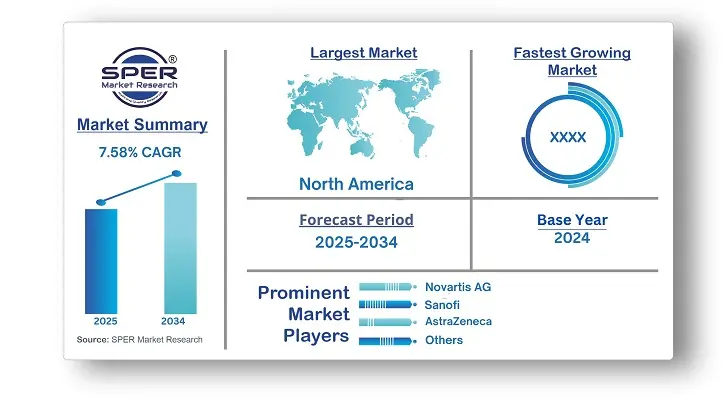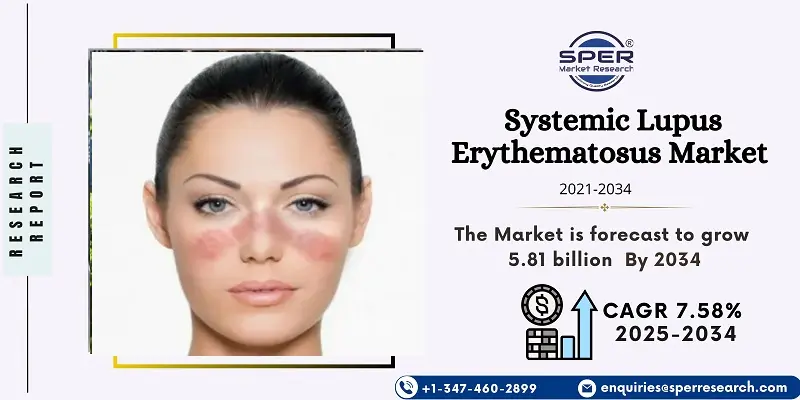Systemic Lupus Erythematosus Market Introduction and Overview
According to SPER Market Research, the Global Systemic Lupus Erythematosus Market is estimated to reach USD 5.81 billion by 2034 with a CAGR of 7.58%
The report includes an in-depth analysis of the Global Systemic Lupus Erythematosus Market, including market size and trends, product mix, Applications, and supplier analysis. The market for Systemic Lupus Erythematosus (SLE) is expanding as a result of greater awareness of lupus and the increasing prevalence of autoimmune disorders. Biologics developments, tailored treatments, and government programs promoting patient care and research are important motivators. Better diagnostic methods and an increasing emphasis on individualized therapy are also driving the need for efficient treatment alternatives. However, obstacles to market expansion include the intricacy of lupus pathophysiology, the high cost of treatment, and the scarcity of disease-modifying medications. Concerns are also raised by the lack of a proven cure and side effects linked to long-term immunosuppressive treatment. Notwithstanding these obstacles, industry expansion is fuelled by ongoing R&D initiatives and regulatory assistance.

By Drug Class Insights
Systemic Lupus Erythematosus is classified into six categories based on Drug Class: Biologics, TNF Inhibitors, NSAID’s, Corticosteroids, Antimalarials and Immunosuppressants. The global market was dominated by the immunosuppressive sector. The segment is mostly driven by how well a medicine manages the symptoms of the disease. The fastest CAGR is predicted for the biologics segment. Growing knowledge and comprehension of the biology underlying the disease is one of the main elements propelling the segment's rise.
By Route of Administration Insights
The market for Systemic Lupus Erythematosus is segmented based on Route of Administration, including Oral, Intravenous and Subcutaneous. The sector with the highest revenue share was oral method of administration. This segment's growth is ascribed to its high patient compliance, ease of administration, and convenience. The fastest CAGR is anticipated in the subcutaneous sector. Increased medication adherence, lower administration costs, and better patient convenience are all benefits of subcutaneous administration.
By Distribution Channel Insights
The market for Systemic Lupus Erythematosus is divided based on Distribution Channel, including Hospital Pharmacy, Retail Pharmacy and Online Pharmacy. The market was controlled by the hospital pharmacy segment. Its broad reach and specialized care options are responsible for this segment's growth. Over the course of the projection period, online pharmacies are expected to see the quickest CAGR. The main drivers of this segment's growth include the expanding e-commerce industry, the growing need for easily available healthcare services, and the uptake of digital technologies.
By Regional Insights
The market for systemic lupus Erythematosus was controlled by North America. The high rate of systemic lupus Erythematosus, the strong healthcare system, and the general knowledge of autoimmune disease are the reasons for the region's dominance. North America's position as a market leader for systemic lupus Erythematosus has been cemented by the region's robust pharmaceutical industry and the presence of major players like GlaxoSmithKline, Eli Lilly and Company, and AstraZeneca. These factors have stimulated innovation and investment in the development of new therapies.
Market Competitive Landscape
The main players in the market are implementing tactics including increased emphasis on R&D, innovative new product launches, partnerships, and acquisitions of other companies in related industries. Some of the key market players are Novartis AG, GSK plc, F. Hoffmann-La Roche Ltd, Pfizer Inc., Sanofi, Lycera (Celgene), Bristol-Myers Squibb Company, ImmuPharma PLC, Merck KgaA, AstraZeneca, UCB S.A.
Recent Developments:
In October 2024, The FDA imposed a clinical hold on Kezar Life Sciences' zetomipzomib mid-stage trial for active lupus nephritis due to safety concerns, leading to four patient deaths.
In September 2024, Dapirolizumab pegol, Biogen and UCB's experimental lupus pharmaceuticals, showed a notable decrease in disease activity in individuals with systemic lupus Erythematosus, meeting the main objective of a late-stage trial.
Scope of the report:
| Report Metric | Details |
| Market size available for years | 2021-2034 |
| Base year considered | 2024 |
| Forecast period | 2025-2034 |
| Segments covered | By Drug Class, By Route of Administration, By Distribution Channel |
| Regions covered | North America, Latin America, Asia-Pacific, Europe, and Middle East & Africa |
| Companies Covered | Novartis AG, GSK plc., F. Hoffmann-La Roche Ltd, Pfizer Inc., Sanofi, Lycera (Celgene), Bristol-Myers Squibb Company, ImmuPharma PLC, Merck KgaA, AstraZeneca, UCB S.A. |
Key Topics Covered in the Report
- Global Systemic Lupus Erythematosus Market Size (FY’2021-FY’2034)
- Overview of Global Systemic Lupus Erythematosus Market
- Segmentation of Global Systemic Lupus Erythematosus Market By Drug Class (Biologics, TNF Inhibitors, NSAID’s, Corticosteroids, Antimalarials, Immunosuppressants)
- Segmentation of Global Systemic Lupus Erythematosus Market By Route of Administration (Oral, Intravenous, Subcutaneous)
- Segmentation of Global Systemic Lupus Erythematosus Market By Distribution Channel (Hospital Pharmacy, Retail Pharmacy, Online Pharmacy)
- Statistical Snap of Global Systemic Lupus Erythematosus Market
- Expansion Analysis of Global Systemic Lupus Erythematosus Market
- Problems and Obstacles in Global Systemic Lupus Erythematosus Market
- Competitive Landscape in the Global Systemic Lupus Erythematosus Market
- Details on Current Investment in Global Systemic Lupus Erythematosus Market
- Competitive Analysis of Global Systemic Lupus Erythematosus Market
- Prominent Players in the Global Systemic Lupus Erythematosus Market
- SWOT Analysis of Global Systemic Lupus Erythematosus Market
- Global Systemic Lupus Erythematosus Market Future Outlook and Projections (FY’2025-FY’2034)
- Recommendations from Analyst
1. Introduction
1.1. Scope of the report
1.2. Market segment analysis
2. Research Methodology
2.1. Research data source
2.1.1. Secondary Data
2.1.2. Primary Data
2.1.3. SPER’s internal database
2.1.4. Premium insight from KOL’s
2.2. Market size estimation
2.2.1. Top-down and Bottom-up approach
2.3. Data triangulation
3. Executive Summary
4. Market Dynamics
4.1. Driver, Restraint, Opportunity and Challenges analysis
4.1.1. Drivers
4.1.2. Restraints
4.1.3. Opportunities
4.1.4. Challenges
5. Market variable and outlook
5.1. SWOT Analysis
5.1.1. Strengths
5.1.2. Weaknesses
5.1.3. Opportunities
5.1.4. Threats
5.2. PESTEL Analysis
5.2.1. Political Landscape
5.2.2. Economic Landscape
5.2.3. Social Landscape
5.2.4. Technological Landscape
5.2.5. Environmental Landscape
5.2.6. Legal Landscape
5.3. PORTER’s Five Forces
5.3.1. Bargaining power of suppliers
5.3.2. Bargaining power of buyers
5.3.3. Threat of Substitute
5.3.4. Threat of new entrant
5.3.5. Competitive rivalry
5.4. Heat Map Analysis
6. Competitive Landscape
6.1. Global Systemic Lupus Erythematosus Market Manufacturing Base Distribution, Sales Area, Product Type
6.2. Mergers & Acquisitions, Partnerships, Product Launch, and Collaboration in Global Systemic Lupus Erythematosus Market
7. Global Systemic Lupus Erythematosus Market, By Drug Class 2021-2034 (USD Million)
7.1. Biologics
7.1.1. Saphnelo (Anifrolumab)
7.1.2. Benlysta (Belimumab)
7.1.3. Phase 3 Pipeline Products
7.2. TNF Inhibitors
7.3. NSAID’s
7.4. Corticosteroids
7.5. Antimalarials
7.6. Immunosuppressants
8. Global Systemic Lupus Erythematosus Market, By Route of Administration 2021-2034 (USD Million)
8.1. Oral
8.2. Intravenous
8.3. Subcutaneous
9. Global Systemic Lupus Erythematosus Market, By Distribution Channel 2021-2034 (USD Million)
9.1. Hospital Pharmacy
9.2. Retail Pharmacy
9.3. Online Pharmacy
10. Global Systemic Lupus Erythematosus Market, 2021-2034 (USD Million)
10.1. Global Systemic Lupus Erythematosus Market Size and Market Share
11. Global Systemic Lupus Erythematosus Market, By Region, 2021-2034 (USD Million)
11.1. Asia-Pacific
11.1.1. Australia
11.1.2. China
11.1.3. India
11.1.4. Japan
11.1.5. South Korea
11.1.6. Rest of Asia-Pacific
11.2. Europe
11.2.1. France
11.2.2. Germany
11.2.3. Italy
11.2.4. Spain
11.2.5. United Kingdom
11.2.6. Rest of Europe
11.3. Middle East and Africa
11.3.1. Kingdom of Saudi Arabia
11.3.2. United Arab Emirates
11.3.3. Qatar
11.3.4. South Africa
11.3.5. Egypt
11.3.6. Morocco
11.3.7. Nigeria
11.3.8. Rest of Middle-East and Africa
11.4. North America
11.4.1. Canada
11.4.2. Mexico
11.4.3. United States
11.5. Latin America
11.5.1. Argentina
11.5.2. Brazil
11.5.3. Rest of Latin America
12. Company Profile
12.1. AstraZeneca
12.1.1. Company details
12.1.2. Financial outlook
12.1.3. Product summary
12.1.4. Recent developments
12.2. Bristol-Myers Squibb Company
12.2.1. Company details
12.2.2. Financial outlook
12.2.3. Product summary
12.2.4. Recent developments
12.3. F. Hoffmann-La Roche Ltd
12.3.1. Company details
12.3.2. Financial outlook
12.3.3. Product summary
12.3.4. Recent developments
12.4. GSK plc.
12.4.1. Company details
12.4.2. Financial outlook
12.4.3. Product summary
12.4.4. Recent developments
12.5. ImmuPharma PLC
12.5.1. Company details
12.5.2. Financial outlook
12.5.3. Product summary
12.5.4. Recent developments
12.6. Lycera (Celgene)
12.6.1. Company details
12.6.2. Financial outlook
12.6.3. Product summary
12.6.4. Recent developments
12.7. Merck KgaA
12.7.1. Company details
12.7.2. Financial outlook
12.7.3. Product summary
12.7.4. Recent developments
12.8. Novartis AG
12.8.1. Company details
12.8.2. Financial outlook
12.8.3. Product summary
12.8.4. Recent developments
12.9. Pfizer Inc.
12.9.1. Company details
12.9.2. Financial outlook
12.9.3. Product summary
12.9.4. Recent developments
12.10. Sanofi
12.10.1. Company details
12.10.2. Financial outlook
12.10.3. Product summary
12.10.4. Recent developments
12.11. Others
13. Conclusion
14. List of Abbreviations
15. Reference Links
SPER Market Research’s methodology uses great emphasis on primary research to ensure that the market intelligence insights are up to date, reliable and accurate. Primary interviews are done with players involved in each phase of a supply chain to analyze the market forecasting. The secondary research method is used to help you fully understand how the future markets and the spending patterns look likes.
The report is based on in-depth qualitative and quantitative analysis of the Product Market. The quantitative analysis involves the application of various projection and sampling techniques. The qualitative analysis involves primary interviews, surveys, and vendor briefings. The data gathered as a result of these processes are validated through experts opinion. Our research methodology entails an ideal mixture of primary and secondary initiatives.



































